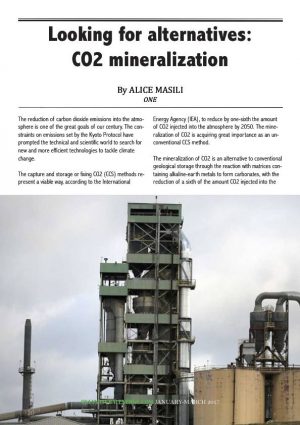 The reduction of carbon dioxide emissions into the atmosphere is one of the great goals of our century. The constraints on emissions set by the Kyoto Protocol have prompted the technical and scientific world to search for new and more efficient technologies to tackle climate change.
The reduction of carbon dioxide emissions into the atmosphere is one of the great goals of our century. The constraints on emissions set by the Kyoto Protocol have prompted the technical and scientific world to search for new and more efficient technologies to tackle climate change.
The capture and storage or fixing CO2 (CCS) methods represent a viable way, according to the International Energy Agency (IEA), to reduce by one-sixth the amount of CO2 injected into the atmosphere by 2050. The mineralization of CO2 is acquiring great importance as an unconventional CCS method.
The mineralization of CO2 is an alternative to conventional geological storage through the reaction with matrices containing alkaline-earth metals to form carbonates, with the reduction of a sixth of the amount CO2 injected into the atmosphere by 2050 (IEA 2013).
The mineralization of CO2 is simply a transformation that occurs naturally over millions of years, through an acid-base reaction in the solid phase as rocks. Researchers have found a way to accelerate this natural aging process of the rocks in order to allow the permanent storage of CO2 in the form of thermodynamically stable calcium and magnesium carbonates.
The most important step is to select suitable minerals containing calcium and magnesium, which are appropriate for the carbonation processes.
This method can be in situ or ex situ. In the first case, mineralization takes place when the injected CO2 hits the alkaline part of the rock in the formation of interest to form solid carbonates. In the ex situ process, the reaction occurs on the surface, inside of a reactor or as a stage of an industrial process.
Recently the use of industrial waste as sources of calcium and magnesium ions has been developed at a pilot scale. In this type of process CO2 emissions, from the exhaust gas of power stations or from cement manufacturing processes, are chemically combined with water and saline solution to form solid mineral carbonates and bicarbonates.
Calera Company and Skyonic Corporation are involved in the development of mineralization technology using industrial emissions. Other ex situ mineralization processes which are currently being developed include that of Integrated Carbon Sequestration (ICS), the Mineral Carbonation International (MCI) and Alcoa.
•Calera Company built a continuous pilot-scale plant in Moss Landing, California that uses fly ashes as an alkaline source to produce on average 5 t/day of cement, aggregates and other related building materials.
•Skyonic Corporation which developed SkyMine & Technology, a process for transforming CO2, acid gases and other heavy metals and pollutants into marketable products, such as sodium bicarbonate, hydrochloric acid, and bleach. The first SkyMine plant has operated since October 2014 in San Antonio, Texas near the Capitol Aggregates cement plant. The plant will reduce carbon dioxide emissions by 15 percent – 83,000 tons of CO2 per year.
•ICS invented and patented a separation process to convert carbon dioxide into ammonium bicarbonate and, after a reaction with silicates, into carbonate and silica. ICS collaborates with important organizations such as the Australian CSIRO (Commonwealth for Industrial Research and Development Organization). Together they performed several experimental to study the effects of temperature and pressure, supported by simulation studies.
•The Australian company MCI aims to transform CO2 in stable carbonates and silicates for the production of construction materials such as cement, gypsum and other valuable industrial products. It built a pilot plant at the University of Newcastle near Sydney, Australia, to scale up and test the commercial potential of mineral carbonation technology.
•Alcoa has developed a process to use the “red mud”, a waste product generated in the industrial production of alumina, to sequester 70,000 tonnes of CO2 per year from the refinery of Kwinana, Western Australia. It is equivalent to 30 tons of “red mud” per tons of CO2.
Currently several large-scale projects study the carbonation of CO2 in situ.
•The Carbfix project (www.carbfix.com) is a collaboration between the Earth Institute at Columbia University, Reykjavik Energy, Icelandic University, and the Centre National de la Recherche (CNRS) in France, with the purpose of mimicking the natural CO2 storage process observed in basaltic rocks on a large scale. The trial site is located in Iceland, near a Hellisheiði geothermal power plant that produces 30,000 tons of CO2 per year. Between 2012 and 2013, they injected 250 tons of water with carbon dioxide and hydrogen sulfide into the ground, at a depth between 400 and 800 meters. After two years, they recorded changes in the isotopic composition of water samples, indicating a substantial start to the solidification process.
•Big Sky Carbon Sequestration Partnership (BSCSP) is a project about the storage of carbon dioxide in rocky areas of Montana, Wyoming, Idaho, South Dakota, and eastern Washington and Oregon, operated in the United States by the University of Montana. In an effort to characterize and evaluate the potential of geological storage sites, the BSCSP is developing a small-scale project near Wallula, Washington for the characterization of geological site in order to guarantee security injection of 1,000 tons of CO2 in a basalt formation at about 1000 m depth.
Alice Masili

